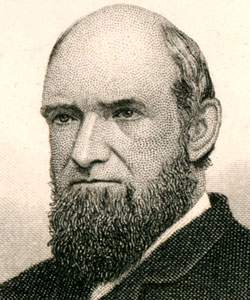John Armstrong Wright (Dickinson Chronicles)
Scholarship
John Armstrong Wright was born in Philadelphia, Pennsylvania, the son of Archibald and Jane Berks Wright, on October 7, 1820. He prepared for college at Wibraham Academy in Massachusetts and entered Dickinson College in Carlisle, Pennsylvania with the class of 1838 in September 1834 when the College reopened under Methodist auspices. A young man of immense size and stature for the time, his career at the College was colorful indeed. He only avoided expulsion for "noise and disrespect" in March 1837 with a direct and formal apology to professor of mathematics Merritt Caldwell, while his membership in Belle Lettres had already seen him fined under society rules for noise and "intoxication." Despite these adventures, the young student also fell under the influence of other professors like John McClintock and John Price Durbin and graduated with an ambition to be a civil engineer and to maintain an abiding connection to the Methodist church.
Wright's first engagement after gaining his degree was to assist in the surveying of the route for the proposed cross state railway line from Harrisburg to Pittsburgh. Other surveying tasks followed such as for the proposed Central Railroad in Georgia in 1841. When the Pennsylvania line was finally begun as the Pennsylvania Railroad Company in 1846, Wright was named as one of the founder members of its board. He was to have a powerful influence in the building of the line, especially in the area of the famous "Horseshoe Curve," and was responsible for both the laying out and the naming of the surrounding railway yards he called Altoona, after a Cherokee word he had heard in Georgia. By this time, he had already seen the advantage of iron production in the "railway age" and had purchased in 1849 the Freedom Iron Works and Greenwood Furnace in Juniata County. These works soon were providing much of the railway equipment and track of the new railroads crossing the state.
The importance of transportation to Pennsylvania's prosecution of the Civil War was not lost on war governor Andrew Curtin and he assigned his fellow Dickinsonian to his staff for co-ordination of the transport of troops and supplies. Wright also assisted with the organization of the Pennsylvania Militia, gaining the honorary title of "Colonel" that he used often during the rest of his life. Wright also served the Commonwealth as a member of the Pennsylvania state tax commission and later as a member of the first Interstate Commerce Commission in 1887. His business affairs had suffered somewhat by 1870 and he had taken up residence as a prominent citizen of his home city of Philadelphia.
Wright married Emma Mineninger Gano of Philadelphia in September 1843. The couple had four girls. His continued affection for his alma mater led to his active membership the Dickinson board of trustees from 1856 until his death while his enduring Methodism had resulted in his helping to found churches in the areas he influenced industrially like Altoona, Burnham, and Greenwood Furnace. He also wrote a well received People and Preachers of the Methodist Episcopal Church. An elementary school is named for him Altoona. John Armstrong Wright died in Philadelphia on November 2, 1891 at the age of seventy-one.
Wright's first engagement after gaining his degree was to assist in the surveying of the route for the proposed cross state railway line from Harrisburg to Pittsburgh. Other surveying tasks followed such as for the proposed Central Railroad in Georgia in 1841. When the Pennsylvania line was finally begun as the Pennsylvania Railroad Company in 1846, Wright was named as one of the founder members of its board. He was to have a powerful influence in the building of the line, especially in the area of the famous "Horseshoe Curve," and was responsible for both the laying out and the naming of the surrounding railway yards he called Altoona, after a Cherokee word he had heard in Georgia. By this time, he had already seen the advantage of iron production in the "railway age" and had purchased in 1849 the Freedom Iron Works and Greenwood Furnace in Juniata County. These works soon were providing much of the railway equipment and track of the new railroads crossing the state.
The importance of transportation to Pennsylvania's prosecution of the Civil War was not lost on war governor Andrew Curtin and he assigned his fellow Dickinsonian to his staff for co-ordination of the transport of troops and supplies. Wright also assisted with the organization of the Pennsylvania Militia, gaining the honorary title of "Colonel" that he used often during the rest of his life. Wright also served the Commonwealth as a member of the Pennsylvania state tax commission and later as a member of the first Interstate Commerce Commission in 1887. His business affairs had suffered somewhat by 1870 and he had taken up residence as a prominent citizen of his home city of Philadelphia.
Wright married Emma Mineninger Gano of Philadelphia in September 1843. The couple had four girls. His continued affection for his alma mater led to his active membership the Dickinson board of trustees from 1856 until his death while his enduring Methodism had resulted in his helping to found churches in the areas he influenced industrially like Altoona, Burnham, and Greenwood Furnace. He also wrote a well received People and Preachers of the Methodist Episcopal Church. An elementary school is named for him Altoona. John Armstrong Wright died in Philadelphia on November 2, 1891 at the age of seventy-one.
John Osborne and James W. Gerencser, eds., “John Armstrong Wright,” Dickinson Chronicles, http://chronicles.dickinson.edu/encyclo/w/ed_wrightJA.htm.



